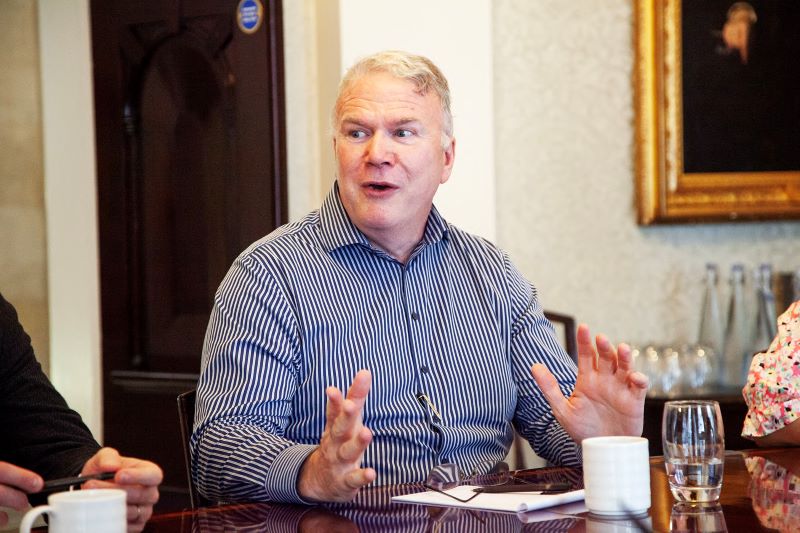
NZI Roundtable: greening DC default funds
The UK’s rapidly growing defined contribution market could play a key role in the country’s transition to net zero. NZI caught up with four DC investors to discuss climate strategies for DC default funds
The UK's defined contribution market has come a long way since millions of British savers were enlisted to workplace pension plans ten years ago.
Since then, the market has grown to more than £500 billion in assets invested on behalf of roughly 23.6 million savers.
While much of these assets are still held in micro-and contract-based schemes, most members are enrolled in master trusts, which now manage more than £100bn. Consequently, these master trusts are widely expected to dominate the UK’s future DC market.
With more than 90% of DC members enrolled in default funds, the net zero journey for these default investment vehicles could play a key role in transitioning the UK’s institutional assets to net zero.

The funds
Net Zero Investor brough together four investors of UK master trusts to discuss greening DC default funds: James Monk, investment director at Fidelity Future Wise, Jonathan Lawlor, actuary and senior consultant at XPS Pension Group which manages the NPT master trust, Callum Stewart, head of investment proposition at Standard Life and Shipra Gupta, investment stewardship lead covering responsible investment at Scottish Widows.
The default approach for Fidelity’s £5 billion master trust is the FutureWise Strategy as it has a carbon reduction budget in place across all asset classes.
Younger members tend to be predominantly invested in developed market equity funds offered by Fidelity and BlackRock, with some allocation to emerging market stocks.
The master trust employs a best-in class approach to avoid sector concentration. For Monk, a key issue is that a lot of carbon data remains backward looking: “What we are focussing on is trying to identify a trajectory of a company from a sustainability perspective and integrating a forward-looking philosophy into our ratings process” he emphasises.
Members of Standard Life’s £5.2 billion master trust will also have a high exposure to developed market stocks in the growth phase. The master trust has transferred the bulk of its default assets to sustainable index strategies and has applied a tilting mechanism to achieve a reduction in its carbon emissions.
This strategy has been largely implemented across the master trust, though legacy arrangements remain in place for contracts based schemes, where individual consent of members is required.
XPS Pensions’ NPT master trust, which has around £1.3 billion in assets, has shifted its assets towards a Transition Pathway Initiative fund which tilts companies based on their relative carbon performance, which has reduced the fund’s carbon footprint by 50%.
Nevertheless, Lawlor, like his peers at the event is not an advocate of downright divestments and puts the focus on engagement instead.
Meanwhile, Scottish Widows' internal RI toolkit covers most of our investment portfolio, including £54billion in Pensions Investment Approaches, the firm's default strategy, it also includes the £2 billion master trust.
The group employs an emphasis on engagement and voting and measured divestment from carbon heavy assets, in addition to ESG integration in its strategic asset allocation, across passive and active strategies.
Scottish Widows also uses its mandates as a tool to influence investment managers to adopt more ambitious climate targets, Gupta explains. Moreover, Scottish Widows also invests around £1.3bn in climate solutions.
“We need to be a lot bolder in terms of what member outcomes mean. Is it really better if a member has a 100,000 in their pension pot but having to spend it on flood proofing their house and living in a hazmat suit?"

Costs and competition
One challenge many DC investors face is that the market remains highly competitive. DC investors aiming to implement more actively managed stewardship approaches are constrained, not just by the charge cap, which limits the maximum charges to 0.75% of funds under management, but also by competition between DC providers to offer more cost-effective investment solutions.
The UK government is currently focussing on shifting the focus on the debate on investment outcome, having launched a consultation on Value for Money in defined contribution earlier this year. The outcome of this consultation has the potential to shape investment approaches on climate change, panellists agree.
Gupta describes the focus on cost in DC as a constant balancing act. “It probably came with the right intentions but has led to a race to the bottom."
She welcomes the government’s ongoing Value for Money consultation as an opportunity to clarify fiduciary duty for DC investors and adopt a more long-term approach.
Stewart also approves of the consultations’ focus on investment outcomes and predicts that in future, there will be more transparent performance league tables for DC providers.
“None of what any of us are describing is purely with a lens of doing right for the world, what we do is about growing pots and in doing so, managing investment risks and capturing investment opportunities” he stresses.
But Gupta emphasises that pension pots cannot be understood in isolation from broader societal problems. “We need to be a lot bolder in terms of what member outcomes mean. Is it really better if a member has a 100,000 in their pension pot but having to spend it on flood proofing their house and living in a hazmat suit? Or end up with a slightly smaller pot but is actually able to use this money because the world they live in has not been destroyed? This concept of double materiality and financial materiality has to come with greater clarification for trustees” she stresses.
Monk counters that considering financial materiality should not necessarily be equated with investment losses.
“There’s an underlying assumption that acting badly will drive better returns. I think that’s entirely false. The longer-term litigation risks of behaving in that way are massive” he argues.
“With that litigation risk on the horizon, I don’t see any gap between a sustainable investment strategy and one that is driving better outcomes, the ones that behave badly will have that litigation risk” he predicts.
"A lot of these climate scenario analyses aren't worth the paper they are written on because we haven't got a model to base it on. If we have a Minsky moment, what do we do?"

While Gupta broadly agrees with this assessment, she warns that DC funds might still be measured by short-term metrics, which do not capture these risks accurately.
Looking at fossil fuel outperformance over the last two years could sketch a very misleading picture, she warns. If you are projecting based on performance now, the funds that had all these fossil fuel players have outperformed funds that did not” she warns. Getting the parameters right to better understand long-term sustainable investment outcomes will be key, she stresses.
Lawlor argues that there are huge variables to these parameters, with recent research by Carbon Tracker highlighting that many funds are still inaccurately measuring the potential financial damages of climate change.
"A lot of these climate scenario analyses aren't worth the paper they are written on because we haven't got a model to base it on. If we have a Minsky moment, what do we do?"
The fact that DC default funds tend to have a much longer investment horizon could favour the establishment of a value for money paradigm focused on the longer term.
“There’s an underlying assumption that acting badly will drive better returns. I think that’s entirely false."

The evolution of tilting
The focus on cost constrains means that the majority of DC assets are invested in index-based strategies centered on listed markets. This still leaves the door open to climate tilts that can be implemented.
For example, Scottish Widows as a group has more than £6bn invested in BlackRock’s ACS Climate Transition World Equity Fund.
Stewart argues that the industry's approach to tilting has evolved in three phases. While the initial phase of tilting could be seen as a blunt instrument focused on managing risks such as exposure to stranded assets, while a more advanced approach would also incorporate investments in climate solutions.
"There will be companies that are large today that won’t exist in the decades to come and new companies that will exist in future”

But a key challenge with that is that it’s too often still based on backward-looking metrics, Stewart believes. The more advanced approach to climate tilting would incorporate a forward-looking outlook.
“I don’t think the market in the very long-term future for members of DC schemes will look as it does today, there will be companies that are large today that won’t exist in the decades to come and new companies that will exist in future” he predicts. One implication of that is that DC investors will have to think more proactively about accessing private markets, he predicts.
A shift to alternatives?
The potential to shift more assets into private markets is a pertinent one for many DC investors. This is in part due to the government’s push to facilitate more private market investment.
Five of the UK’s largest DC Master Trust providers, Aviva; Scottish Widows; L&G; Aegon; Phoenix; Nest; Smart Pension; M&G and Mercer have pledged to commit 5% of their default fund portfolio’s to private markets.
In theory, this could offer an opportunity to invest more directly in climate solutions.
But Monk argues that the materiality of the Mansion House pledge is relatively low: “Rather than it being UK orientated, it became about global investments in private markets and rather than being a hard 5%, it became up to 5%” he says.
At the time of writing, private market allocations in DC default funds are a rare exception, rather than the rule. But panellists agree that in future, they will take on a growing share of DC default allocations, with estimates ranging from 20% to 40% of a growth-oriented default portfolio.
But Lawlor emphasises that in practice, this allocation would have to be staggered over time with posts expected to grow significantly driven by member contributions.
Another potential challenge for DC investors are rules on daily pricing, which have been easier to avoid for schemes that don’t go through Life Insurance Companies, Monk adds. Another option are quasi liquid versions of private markets.
“The danger here is that DC funds, by being so desperate to invest in private markets but being cost constrained, implements it in a way that is not resulting in the best outcomes investing in the lower quality end of the spectrum” Monk warns.
Stewart is nevertheless broadly optimistic on the opportunities in private markets. He predicts that if the budget to invest member’s money was increased by ten basis points, that could support an allocation to private assets of at least 10 percent of the overall portfolio, which in turn could improve retirement outcomes by 10%.
All panel members agree that in order for a private market asset to be included in a DC portfolio, it would have to present members with a suitable case.
With the risks of DC investments ultimately born by members, finding the right balance between tackling climate risks and offering reliable returns is set to become a key challenge for DC investors.
Also read
Ontario Teachers Pension CEO Jo Taylor: ‘voting against directors sets the tone for change’




